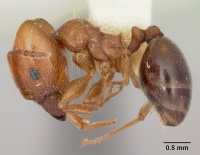Pheidole bureni
| Pheidole bureni | |
|---|---|

| |
| Scientific classification | |
| Kingdom: | Animalia |
| Phylum: | Arthropoda |
| Class: | Insecta |
| Order: | Hymenoptera |
| Family: | Formicidae |
| Subfamily: | Myrmicinae |
| Tribe: | Attini |
| Genus: | Pheidole |
| Species: | P. bureni |
| Binomial name | |
| Pheidole bureni Wilson, 2003 | |
Nothing is known about the biology of bureni.
Identification
See the description in the nomenclature section.
Keys including this Species
Distribution
Only known from the type locality in Texas.
Distribution based on Regional Taxon Lists
Nearctic Region: United States (type locality).
Distribution based on AntMaps
Distribution based on AntWeb specimens
Check data from AntWeb
Countries Occupied
| Number of countries occupied by this species based on AntWiki Regional Taxon Lists. In general, fewer countries occupied indicates a narrower range, while more countries indicates a more widespread species. |

|
Estimated Abundance
| Relative abundance based on number of AntMaps records per species (this species within the purple bar). Fewer records (to the left) indicates a less abundant/encountered species while more records (to the right) indicates more abundant/encountered species. |

|
Castes
Images from AntWeb
   
| |
| Paratype of Pheidole bureni. Worker. Specimen code casent0172963. Photographer April Nobile, uploaded by California Academy of Sciences. | Owned by MCZ, Cambridge, MA, USA. |
Nomenclature
The following information is derived from Barry Bolton's Online Catalogue of the Ants of the World.
- bureni. Pheidole bureni Wilson, 2003: 150, figs. (s.w.) U.S.A.
Unless otherwise noted the text for the remainder of this section is reported from the publication that includes the original description.
Description
A member of the crassicornis group distinguished by the following combination of traits.
Major: scape flattened at base; head in side view narrowed, its posterior dorsal surface flat; in full-face view, occipital border deeply concave and occipital lobes subangulate; propodeal spines long and vertical to propodeal dorsal face; pronotum transversely carinulate; mesosoma and waist completely foveolate and opaque; pilosity very sparse.
Minor: all of body foveolate and opaque except gaster, which is smooth and shiny; carinulae mesad to eyes extend to occiput.
MEASUREMENTS (mm) Holotype major: HW 1.50, HL 1.58, SL 0.80, EL 0.24, PW 0.76. Paratype minor: HW 0.72, HL 0.80, SL 0.80, EL 0.20, PW 0.48.
COLOR Major: bicolorous, with all of body reddish yellow except gaster, which is medium to dark reddish brown.
Figure. Upper: holotype, major. Lower: paratype minor. Scale bars = 1 mm.
Type Material
TEXAS: Alice, Jim Wells Co., southern Texas, col. William F. Buren. Florida State Collection of Arthropods and Museum of Comparative Zoology
Etymology
Named after the collector, the late American myrmecologist William F. Buren.
References
- Wilson, E. O. 2003. Pheidole in the New World: A dominant, hyperdiverse ant genus. Harvard University Press, Cambridge, MA. (page 150, fig. major, minor described)
- Vazquez-Franco, C.M., Castano-Meneses, G., Rios-Casanova, L., Morrone, J.J. 2024. Three new species of Pheidole Westwood, 1839 (Hymenoptera: Formicidae: Myrmicinae: Attini) from central Mexico. Zootaxa 5523(2), 192–210 (doi:10.11646/zootaxa.5523.2.3).
References based on Global Ant Biodiversity Informatics
- McDonald D. L., D. R. Hoffpauir, and J. L. Cook. 2016. Survey yields seven new Texas county records and documents further spread of Red Imported Fire Ant, Solenopsis invicta Buren. Southwestern Entomologist, 41(4): 913-920.



